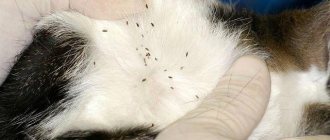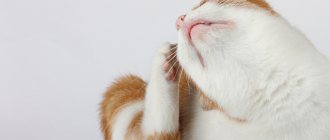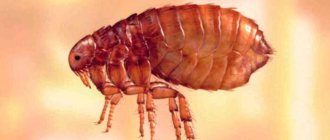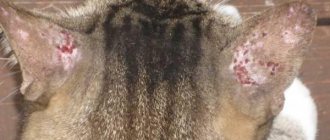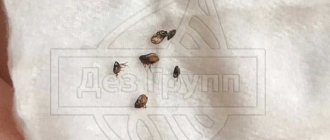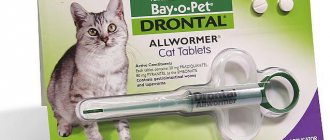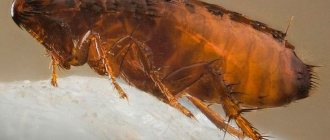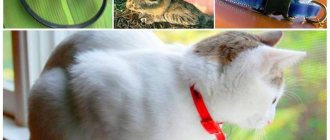Fleas on pets are an unpleasant phenomenon that should be combated: this can be done at home, using pharmaceutical and folk remedies.
- Pets bring joy to their owners and become best friends
- But when our younger brothers get sick, this becomes the main problem for the whole family
- There are diseases that cause discomfort to both animals and their owners - for example, parasites , which are frequent guests in their luxurious fur
- We're talking about fleas . In this article we will study in detail how to deal with these insects.
Fleas on dogs
Dogs need to be walked regularly, so the risk of picking up parasites is high. This usually occurs upon contact with a source of spread (basement, entrance) or with a stray dog. Stray animals are carriers of all kinds of parasites and diseases, so do not allow your pet to come into contact with homeless relatives. The easiest way to protect your dog from fleas is to wear a special collar that repels pests with its composition, but this is only a preventive measure.
FAQ
How to get rid of fleas in the house?
This is a very important point, because otherwise you will not get rid of fleas.
- Vacuum cleaner! A very effective method, since its noise and vibrations stimulate the hatching of pupae (and they are considered unkillable)
- Wet cleaning using special products, for example: Entomazan, Deltsid. It should be diluted according to the instructions and several treatments should be carried out at intervals of a week.
- Surface treatment with sprays: Dana-ultra or Bolfa.
- To treat hard-to-reach areas, you can use products with Dimethicone. You shouldn't treat the floor with them, they will slip.
What flea medications can pregnant and lactating dogs use?
Pregnant dogs and those nursing puppies should be prescribed flea treatment by a veterinarian. Here is a list of safe active ingredients for pregnant and lactating women:
Isoxozolines (nexgard and bravecto tablets). Deltamethrin and flumethrin from the pyrethroid series. Phenylpyrazones Selamectin (as part of Stronghold).
What diseases can be confused with?
Itching in a dog can be a symptom of many diseases associated not only with skin inflammation and parasites, but also with hormonal disorders. But fleas are always eliminated first, so periodic treatments are required!
Fleas on cats
Although usually a cat seems to be a peaceful domestic inhabitant who never leaves the apartment, some cats really like to escape into the entrance hall, where they can pick up parasites on their fluffy fur. The consequences of such a walk appear after a few hours; the pet begins to actively itch, but cannot eliminate the cause of the itching. Sometimes traces of scratching become red, six in these places fall out, and occasionally it comes to bleeding scratches. Try not to let your cat into the entrance or onto the street, and make trips to the veterinarian using a carrier.
Prevention of infection
Preventive measures will help to avoid flea infestations and subsequent control of them. Dog owners should inspect and wash their pets more often, as they are outdoors every day and come into contact with other animals. But it is also recommended that owners of domestic cats periodically treat their pets and their resting places with special products.
The house should be wet cleaned regularly - parasitic insects do not like to live in clean areas. It is better not to keep the door to the entrance open, then the fleas will not have time to jump into the apartment. Pet owners should take care of their clothes and shoes and clean them after being outside.
Symptoms of fleas in an animal
At first, fleas may not show themselves, so it may seem that they appeared “out of nowhere.” If your pet begins to actively and incessantly scratch, this is the first alarming sign. Restlessness, licking and combing fur until bald spots are a clear sign of fleas. Examine the area where you scratched, see if there is any redness or scratches, and treat the affected areas. Spread the fur with your fingers in several places and you can determine the presence of fleas. How to save your pet from suffering?
What to do if you find fleas
If you find even one flea on your dog, you need to act as follows.
- Do not delay treatment - fleas multiply at high speed. It will only take a few days for the pet to stop sleeping and eating, and for the insects to penetrate into all surrounding objects. It will be much more difficult to get them out of there than with a dog. In addition, in this case, there remains a high risk of re-invasion.
- Take a comprehensive approach to eliminating parasites. In addition to the pet, you will have to treat the room in which he lives (in the case of the street, this is an enclosure, a booth, everything that is in them). To ensure that you get rid of bloodsuckers, you will need to use not only folk, but also industrial pest control products.
- The drug for treating your four-legged friend must be selected in accordance with its characteristics, for example, age, attitude to washing, and state of health. Ideally, you should consult a veterinarian, but advice from people who have already encountered such a situation and successfully overcome it is also acceptable.
- During the period of disinfestation measures, the dog must be in “quarantine” - it is worth limiting it from free walking and communication with unfamiliar relatives.
Folk remedies for fleas for pets
To rid your pet of fleas, you can use the following safe folk remedies:
- Sagebrush. This product is completely natural and does not contain toxins. To prepare the decoction you will need one tablespoon of wormwood and boiling water. The herb is poured with hot water, after which the decoction should steep for several hours, and, of course, cool. The resulting mixture must be rubbed into the fur and skin of the animal.
- Eucalyptus leaves or tansy are suitable for the same method . But plant decoctions are most often used as prophylactic agents. If there are a large number of parasites, then they will not help here.
- If the infestation is severe, you can prepare a saline solution . Mix table salt and water in equal parts. The solution should be used to treat the carpets in the house, as well as the pet itself. The mixture should be left overnight and cleaned from the carpets in the morning using a vacuum cleaner. Pets are simply combed well to remove parasites.
- Fleas have an extremely negative attitude towards the pine smell . For pets, you can make special beds filled with spruce or pine shavings, and you can add dried wormwood to it.
- Using 3% vinegar essence and cologne , you can also get rid of parasites. The mixture is applied to the pet’s fur, and the animal is covered with polyethylene for several hours, excluding the head. After 30 minutes, the fleas need to be combed out over a basin and the contents poured into the toilet.
- Salt water may also help. You will need 1 pack of salt per bucket of water; you need to dissolve it well and then bathe the animal. Salt can be replaced with wormwood decoction , but you need to carefully ensure that the liquid does not get into the pet’s mouth.
- Along with bathing, you can treat the animal with tar or laundry soap .
Application procedure
Insectoacaricidal drops Bars® Forte are used by animals once by drip application to dry, intact skin at several points in the back between the shoulder blades or in the neck at the base of the skull (in places inaccessible to licking by animals) in the doses indicated in the table.
| Type and weight of the animal | Volume of the drug in the pipette (ml) | Drug dose (ml) per animal | Number of pipettes required for processing (pieces) |
| Dogs | |||
| from 2 to 10 kg | 1.4 | 1.4 | 1 |
| from 10 to 20 kg | 1.4 | 2.8 | 2 |
| from 20 to 30 kg | 1.4 | 4.2 | 3 |
| from 30 kg to 50 kg | 1.4 | 5.6 | 4 |
| Cats | |||
| up to 1 kg | 1 | 0.3 (10 drops) | — |
| from 1 to 3 kg | 1 | 0.6 (20 drops) | — |
| from 3 kg or more | 1 | 1 | 1 |
When treating dogs
weighing more than 50 kg,
an additional 1.4 ml of the drug is applied for each subsequent 10 kg.
Repeated treatments of animals are carried out according to indications, but not more than once a month.
To prevent re-infestation by fleas
animals are given bedding replaced or treated with an insecticidal agent in accordance with the instructions for its use.
To destroy ixodid ticks on the animal’s body
The drug in the amount of 1 drop is applied to the tick and the place of its attachment to the skin. If within 20-30 minutes the tick does not fall off spontaneously, then it is carefully pulled out of the body with tweezers and destroyed.
The duration of the protective effect lasts for 1-2 months.
Flea Control Chemicals for Pets
It is not always possible or convenient to use folk remedies, or you need to immediately get rid of annoying parasites, then chemical compounds come to the rescue. They come in different forms and methods of application, they are very effective, but they must be used with great care! We list the main flea remedies for dogs and cats.
- Anti-flea collars are suitable as prevention , but it is worth remembering that they have a limited validity period, usually several months. As the expiration date comes to an end, you need to buy a new collar. Cats are harder on collars than dogs, so this method is not suitable for everyone.
- There is a remedy similar in action to a collar - drops . They are applied to the animal’s withers, which will prevent it from licking off the active substances that repel and destroy fleas. The drops are quite effective and easy to use.
- More gentle means are powders . They contain a minimal amount of insecticides. Treatment with flea powder needs to be carried out several times, and its validity period is minimal, so it is not in great demand among pet lovers.
- Spray against fleas contains many insecticides and other harmful substances, so its effect is maximum, pests are eliminated instantly. But don't overdo it! Follow the instructions on the package, spray the required amount from the bottle and rub it into the dog or cat's fur. In order to protect your animal from chemical poisoning, wear a special collar to prevent licking of the fur. Spray the substance carefully, do not inhale its vapors and do not get it in the eyes of yourself or your pet!
Drops "Clandestine" for dogs and cats
This is a product with an insecticidal composition that does not irritate the animal’s skin when applied. Flea celandine is available in the form of dispensing pipettes and is effective immediately after use. Its components are effective for about two months.
Disadvantages of the drug:
- Allergic reaction in a pet;
- The animal must not lick the product from its fur;
- The drug should not be used on puppies or kittens up to eight weeks old, or on sick or pregnant pets.
The rules of use and dosage are clearly indicated in the instructions for use.
Attention:
- You can get rid of pests with maximum results if you treat both your pet (especially its place) and the entire room.
- Do not bathe the animal for several days after treatment.
- Wearing a flea collar and treating with Celandine drops are incompatible.
DIY flea shampoo
If you do not trust the composition of the flea shampoo sold in the pet store, or do not want to overpay, prepare your own anti-flea shampoo. For this you will need:
- baby soap;
- medium sized onion;
- egg yolk;
- calendula or chamomile.
The soap is grated using a coarse grater and filled with warm water. The resulting mixture must be brought to a boil to obtain a mass similar in consistency to jelly. You also need to add the grated onion there. Boiled chamomile (can be replaced with calendula) and egg yolk are poured into the finished product and mixed thoroughly. Lather the pet with shampoo, cover it with polyethylene and leave it for half an hour. Then everything is thoroughly washed off.
Could your cat have lice, where do they come from? Symptoms of infection
The problem of lice infestation is especially acute for cats that occasionally go outside for a walk. By communicating with its relatives, a pet can easily “catch” an unpleasant disease.
The following symptoms indicate whether your cat has lice:
- Dry, loose fur;
- Baldness of some areas of the skin;
- Itching;
- Anemia.
You can find out if a cat is infested with lice by carefully examining your pet's skin and fur. Nits and adults of these parasites are visible to the naked eye.
- Shampoos for external parasites. Special pet shampoos against ectoparasites have a detrimental effect on lice. After soaping the animal, the shampoo should be left on the pet for at least 10 minutes and only then rinsed thoroughly. Then it is recommended to comb the cat and dry it. If your pet tolerates the bathing procedure calmly, then washing with zoo shampoo will not give him any unpleasant sensations.
- Collars against fleas, lice, ticks. Collars destroy lice on the animal and protect the pet from re-infestation. However, often with constant wearing of such a collar, animals experience an allergic reaction.
How to remove parasites
Your dog should be treated for fleas immediately and the treatment should be comprehensive. You should not try to simply eliminate the itching, you need to make efforts to fight the parasites.
Advice . Before purchasing a flea remedy, you need to study the features of the product. Thus, many products are suitable not only for eliminating common dog parasites, but also for preventing the appearance of fleas. And the latter painfully bite not only animals, but also people.
Shampoo
Flea shampoos
are especially popular for bathing young dogs, because not every adult dog approves of water treatments. Most shampoos contain insecticides and natural herbs.
The first option is more toxic and kills parasites much faster and better. The downside of shampoos is possible side effects (stomach upset, vomiting, allergies). The owner must carefully ensure that during bathing the foam from the shampoo does not get on the pet’s eyes or mucous membranes.
Natural shampoos are used for prevention - they help wounds heal easier and make dogs' coat silky and healthy. The result will be more noticeable if other means to get rid of fleas are used along with natural shampoo.
The most popular flea shampoos among dog owners are Bars, Lugovoi, etc.
Spray
They are easy to use - you only need to spray the sprays over your pet’s withers. However, this method of treatment can be potentially dangerous for the animal if the dog begins to lick itself. The result may be adverse reactions: allergies, vomiting, weakness.
The procedure is carried out in a thoroughly ventilated room or outside. It is better for the owner to use rubber gloves during processing. The treated area should not be touched for 24 hours (it is especially important to instill this in children who love to play with their pet). During the treatment period, the owner is strictly prohibited from sleeping in the same bed with the pet.
The most popular flea sprays are “Bars”, “Beaphar”, “Hartz”, “Frontline”, etc. The latter option is suitable for removing fleas even from newborn puppies.
Drops
This product is suitable for both small (for example, Spitz) and large breeds of dogs (shepherd, St. Bernard) and is considered more effective in comparison with shampoo and spray.
Flea drops are distributed on the pet's withers in the amount specified in the instructions.
Important! The dog should not lick the applied drops!
When the active substance in the drops enters the bloodstream, it destroys fleas. During this period, the dog cannot be bathed. As a rule, the result lasts for a month, then the treatment should be done again.
Advice . Not all drops are considered safe and harmless. To prevent poisoning of your pet, it is important to discuss the choice of drops with your veterinarian.
Often dog owners choose “Barrier”, “Insectal”, “Blokhnet”, “Advocate”, “Practik”, “Advantix”, “Bars Forte”, “Clandestine”, “Inspector”, “Frontline” and so on.
Read more in our article: TOP 8 best drops for fleas and ticks in dogs
Collar
A flea collar
is considered the most effective option. Its main advantage is continuous action. At the first sign of fleas, a collar is put on your pet. This product protects the dog from getting the active substance into the bloodstream - the animal can even wash and swim. No additional processing is required.
However, flea collars also have disadvantages:
- They are not suitable for puppies under six months of age and dogs over 10 years old.
- Some samples are highly toxic, so you cannot wear them all the time.
- Accessories are not suitable for pregnant or lactating dogs.
- Continuous wearing of a collar in some cases provokes dermatitis.
The most popular options for dog collars are Hartz, Bars, Celandine, Rolf Club, Foresta, etc. Products are also sold that can repel parasites with ultrasound, but they are not recommended for use in combination with other products.
Powder
One of the main advantages of flea powder is its low price. The main disadvantage is the duration of treatment (from 14 days). Before use, you should check the dog's reaction to exclude possible skin reactions.
In some cases, the powder provokes side effects (dermatitis or allergies).
Pills
Chewable flea tablets are not as common as other products. The principle of their action is simple: the tablet is placed in the animal’s food. After some time specified in the instructions, the procedure is repeated.
Many dog owners do not rely on tablets because they believe they do not completely remove fleas, but only reduce their numbers. Side effects from taking the pills may include allergies and stomach upset.
The most popular tablets for dogs with an anti-flea effect: “Sentinel”, “Comfortis”, “Capstar”, etc.
Treating the area where the dog lives
To remove fleas from a dog, it is not enough to treat only the pet. The insects living next to it will return to the “host” as soon as the drug expires. Therefore, it is necessary to simultaneously carry out a thorough disinfestation of the premises (apartment, house, booth) in which the pet lives.
Treating your apartment for dog fleas
There are several ways to disinfect an apartment. You can use one, the most suitable one, or you can use several at once.
- Thermal impact. If the temperature outside is sub-zero, it is enough to take the things in which fleas have settled outside for a few hours outside. Insects can also be killed by exposing them to boiling water (by dousing or boiling them).
- Chemical attack. Products such as Karbofos, Reid, Fenaxin and the like are used to treat floors, walls, corners, utility rooms, and large interior items (for example, upholstered furniture). You can use insecticidal preparations in the form of a spray or powder that were used to treat the dog. It is important that there is not a single untreated corner left, otherwise the processing will have to start all over again.
- Traditional methods. Among the folk methods for treating an apartment from dog fleas, the same means are used as for disinsection of a pet. These are: wormwood, kerosene, pine sawdust and others. Only kerosene treatment leads to the death of insects; other methods can be used as a complement to the chemical option. Infusions and decoctions are prepared from the plants, which are used to wipe all surfaces in the house, preferably several times a day. As an option, spread fresh wormwood around the apartment (along the baseboard, in corners, under furniture), and change it as it dries for a month (minimum).
- The professional way. The services of special services for exterminating fleas indoors are sought in difficult situations, when other methods are ineffective. The essence of professional treatment is the artificial creation of fine vapor particles containing an insecticide. These particles settle on surfaces, penetrating deep into porous materials, causing the death of insects.
Processing the dog house
When removing fleas from a dog, you also need to put things in order in the kennel. To destroy insects, the same methods and preparations are used as in the apartment. The litter must be burned, and to prevent the return of bloodsuckers, branches of wormwood or tansy should be laid out inside and around the booth (they should be periodically replaced with fresh ones).
Herbal remedies
Sagebrush
Silver wormwood is used against fleas. Thanks to the leaves and stems of a silvery color, this species is distinguished from common wormwood, which does not act on fleas. But it is worth considering that wormwood slightly stains white fur with a greenish tint.
Chopped grass (1 tbsp) is poured with vodka (1 glass). After 2 weeks of infusion with periodic shaking, the tincture is rubbed into the dog’s skin. It is also added to water when washing floors, and sprayed on areas where parasites accumulate.
Garlic
Wormwood and garlic are effective against fleas. 20 grams of dry herb (or 40 g of fresh) are poured with boiling water (0.5 l) and boiled for 15 minutes. Cool.
Chop a couple of cloves of garlic, add 0.5 liters of cold water and leave overnight to infuse. In the morning, a decoction of wormwood and garlic tincture are combined. The resulting product is used to wipe the dog's fur. Garlic is toxic to her, so her attempts to lick the fur should be stopped.
Garlic infusion can be used to separately wipe the head and neck area so that the dog cannot lick off the substance that is harmful to it. Two finely chopped garlic cloves are poured with a glass of water and left for 8 hours.
Onion
Dissolve laundry soap shavings in a glass of water, add finely chopped onion. The mixture is kept on the dog’s body for 5 to 10 minutes and washed off. If necessary, the process is repeated.
Appearance of parasites
Knowing what fleas look like is necessary in order to be able to distinguish these parasites from other types of arthropods, such as ticks.
A flea is a wingless, blood-sucking insect that parasitizes animals and feeds on their blood. Its body shape is oval, slightly flattened at the sides.
The parasite has 2 pairs of short legs, as well as elongated hind legs, with the help of which the insect can push off, making long jumps. Body color is brown or black, length 2–5 mm.
On the small head there is a sharp proboscis, with the help of which the parasite easily pierces the skin of the victim.
At the moment of a bite, the flea injects an enzyme that prevents blood clotting. The body of the parasite is covered with bristles, which help it cling to the animal's fur.
Having reached sexual maturity, the flea begins to lay eggs, from which larvae resembling worms hatch after a few days. After several moults, they grow into adults.
The entire cycle takes about 2 weeks and can increase under unfavorable living conditions.
Safety rules for processing
Since killing fleas on dogs and indoors involves the use of highly toxic chemicals, precautions must be taken.
- Do not use drugs and products that have expired;
- carefully read the instructions for using a particular product, especially when it comes to treating puppies, weakened and pregnant animals;
- if it is not possible to contact a specialist, when choosing a drug, pay attention to the dosages indicated in the instructions, the characteristics of the animal’s age, and recommendations for further observation;
- if your pet becomes ill during the procedure, you need to urgently take him to the clinic or call a specialist at home;
- Before you start disinfesting the premises with chemicals, you need to remove all household members, including pets;
- Processing should be carried out using rubber gloves and a respirator (or medical mask);
- After the disinfestation is completed, you must leave the apartment, wash your face and wash your hands.
You can return to the treated room after the period specified in the instructions for the product used.

